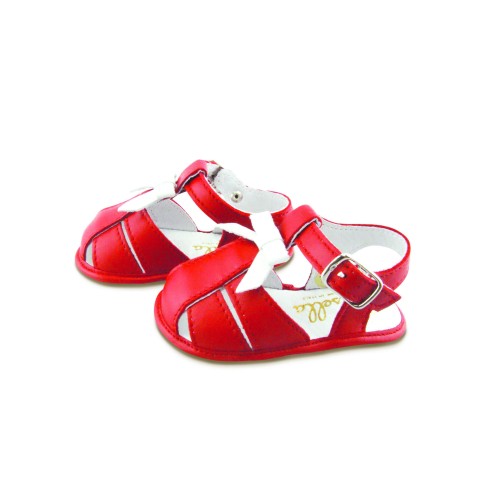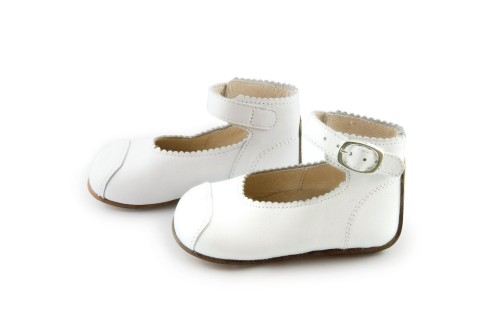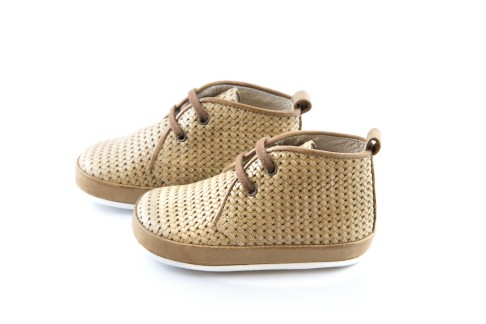
What to look for when buying shoes for toddlers
The best footwear for young children is none at all, experts say. But for parents who are determined to put their youngsters in shoes, here are some tips

If you've been searching for that perfect pair of shoes for your little one, you may be surprised to learn the best foot gear has been right before your eyes: bare feet.
"Kids should not be wearing shoes before they're walking," says Douglas Horne, a UK-trained podiatrist with a private practice in Hong Kong. "And whenever practically possible, children should not wear shoes."
Brock Healy, director and principal podiatrist at the Hong Kong Foot Clinic, seconds that opinion. "Certainly, in the earlier years, we believe less is more as a general rule," he says, adding that barefoot or socks is best.
"It is important that the muscles in toddlers' feet are allowed to strengthen and develop through natural stabilisation. This allows the toes to grip onto the ground and the 'arch' of the foot to strengthen. Harder soled shoes can reduce this due to external stabilisation."
If you'd like to have your child wear shoes, then in the early years the purpose should only be for protection - whether from uncomfortable or dangerous walking surfaces or from the elements such as sun, rain or cold.
For vanity's sake? That's fine occasionally too, Healy says, as long as the footwear is loose-fitting and soft soled.

Likewise, Horne recommends something "as unstructured as possible" so that babies can get feedback as they claw their toes and learn about balance.
The adult foot is a very dynamic, complex structure with 26 bones, 300 ligaments and about 50 muscles, Horne explains. A baby's foot is contains more cartilage than bone. At about age two, the bones will start to delineate, but the bones will not fully develop and harden until about age 18.
Baby feet are very soft and malleable. That means they can be easily moulded and deformed by ill-fitting footwear, says Healy.
Healy adds that, unlike adults, babies don't really have an arch in the foot until about the age of four, because they are born with a large fat pad sitting under the arch. So most infants' or toddlers' feet look flat.
The effects of putting on footwear from a young age have been researched in various studies, Horne says.
"For example, they've gone to communities that do not wear shoes and found the number of foot deformities is much lower than among people in populations who wear shoes," he says. "That seems to say that footwear is at least partly responsible for the foot deforming."

One such study, from 1991, by Dr Lynn T. Staheli, then-director of orthopaedics at Children's Hospital and Medical Centre in Seattle, looked at anthropological studies around of the world of people who do not wear shoes.
Staheli found that in China, for example, the feet of non-shoe-wearers have better flexibility and mobility, are stronger and have fewer deformities and complaints than people who wear shoes.
More than 20 years later, if Staheli repeated the study, he might find it more of a challenge to find people who didn't wear shoes. According to a report issued in June by the Trade Development Council, the mainland has been the world's biggest footwear consumer since surpassing the US in 2011.
Based on estimates from research firm Euromonitor, China's footwear market will continue to grow at more than 9 per cent a year, and, in 2015, will amount to 380 billion yuan (HK$468 million), with more than 10 per cent contributed by children's shoes.
"Children's footwear enterprises are placing greater emphasis on producing healthy shoes. Elements such as the style, quality and comfort of shoe products directly influence the buying decision of consumers," the report says.

A recent brand to join the mainland market is Gusella, an Italian children's shoemaker that opened a store in Beijing in April last year. The 83-year-old luxury brand, offering shoes that cost upwards of about HK$1,600, also expanded into Hong Kong in November.
Although its price tag may rival, and its designs mimic those of adult shoes, Gusella's executive director Caroline York says the shoes are not simply mini versions of adult footwear. The brand's shoe categories include Culla (cradle), Gattona (crawling) and Primi Passi (first steps), each designed specifically for different developmental needs.
Its most popular shoe, the Gusellino from the Gattona range, for example, offers high ankle support to prevent unsteady ankles from rolling over; reinforced toe caps and heels to protect toes from bruising during crawling and initial attempts at standing; and a unique L-shaped sole to aid more fluid movements from sitting to standing position.
Horne says he's always "very concerned" when he sees children in mini versions of adult styles such as trainers.
"You often see dad wearing Nike Air Max and the child in a baby version. Such trainers are quite stiff in general and they have a lot of structure. They're not great for early walkers," says Horne. "Any shoes that are copies of adults shoes are generally quite stiff."
Crocs, flip flops and ballet flats are also no good for children, he says, as they don't offer much stability.
"We're all born with the potential for perfect feet," Horne says, "but if you apply a very natural dynamic piece of equipment - which is your foot - to an unnatural environment, such as concrete, then you'll see some problems, especially if the shoes are not the correct ones."
How to make sure the shoe fits
Podiatrists Brock Healy and Douglas Horne offer advice on footwear for your child.
- Six to 12 months: socks with dimples underneath for traction; shoes with soft material on the upper and bottom, and are loose fitting with no fastenings.
- First steppers (up to 18 months): a shoe with a straight last and a very flexible sole, fastenings such as straps are recommended to prevent shoe from falling off or infant tripping;
- Toddlers (up to 2½ years): a slightly more structured shoe but still very flexible - if you hold it at its waist, you should be able to bend the shoe with hardly any pressure.
- Ideally, buy shoes from a shop with a trained fitter. A general rule is there should be about a centimetre of space at the front of the shoe. Toddlers should be measured for shoes when standing as the foot elongates and spreads when bearing weight.